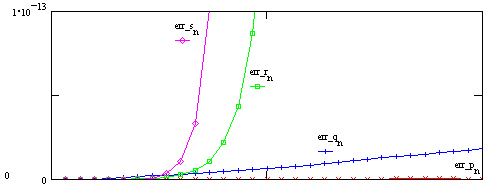MATH/CSC 381
Numerical Methods
Dr. John Travis
MCC 315
925-3817 (leave voice mail if no answer)
Email: travis@mc.edu
Problems:
- Finite Precision Machines -- round-off errors.
(Computer arithmetic is not exact. A finite mantissa and exponent give rise
to only a small subset of rational numbers are expressible on a computer.)
- Approximate mathematical models -- truncation
errors. (Finite means of approximating continuous or unknown quantities.)
- Convergence - Stopping an iterative process
before completed. (Can't let a process complete an infinite number of steps.
Models may asymptotically converge. On a machine, one may only implement a
finite number of steps in such a procedure. Hence, stopping before convergence
yields an error.
Good Programs are (a) reliable, (b) robust, (c) portable,
and (d) maintainable
Goal: To produce reasonably accurate results
in the presence of (1), (2) and (3) above.
Roundoff Errors
- machine numbers y = ±0.d1d2...dk
*bn, where
- b = base of machine,
- n=#of digits in exponent,
- k=#of digits in mantissa,
- dj = jth digit, such that d1
is nonzero.
- underflow 0 < |y| < 0.1 * bminimum, overflow
|y| > 1 * bmaximum.
- Notice that combining integer data using addition, subtraction or
multiplication will always yields exact results except in the case that overflow
is reached.
- The set of machine numbers is a very small subset
of the rational numbers. For an actual real number x = ±0.d1d2...dkdk+1
... bn,
the computer can only represent the "closest" machine number, denoted by
fl(x).
- Chopping yields fl(x) = first k digits
of x, regardless of the (k+1)st digit
- Rounding yields fl(x) =chopped (x + 0.5
bk).
- Absolute error. If p =
exact, p* = approx. yields absolute error = | p - p*|. For computer calculations,
|x - fl(x)| = 0.dk+1 ... bn-k.
- Relative error - generally a better estimate
of how bad an approximation really is. | p - p* | / | p |
- Significant digits - number of decimal
places which are known to be accurate
Numerical Crimes: Things which lead to loss of
significant digits...
- Differencing nearly equal quantities - significant
digits may cancel leaving an answer with fewer significant digits.
- Multiplying by large quantities - significant
digits might double so that machine number can't maintain all of them.
- Dividing by small quantities - similar to (2).
HOMEWORK PROBLEMS, page 14, #3, 4, 5, 8
Ex. Consider quadratic formula in various forms.
Notice, mathematically each method is equivalent.
Remark: Rounding errors introduce errors in
repeated calculations in the same way that incorrect data does.
Stability: Small changes in the "initial" data
yields correspondingly small changes in the final result.
Ex: xn=(2/3)n, n>0
found recursively by one of the four methods:
(a) pn= (2/3)pn-1, which is a
stable algorithm, with the relative error "err_p" virtually zero
(b) qn= (7/6)qn-1 - (1/3)qn-2,
which is stable, with the relative error "err_q" the next best, only increasing
linearly. Note, the recursion above also has as a solution (1/2)n,
where 1/2 < 2/3.
(c) rn= (17/12)rn-1 - (1/2)rn-2,
which is "relatively" stable, with the relative error "err_r" increasing
exponentially. Note, the recursion above also has as a solution (3/4)n,
where 3/4 > 2/3, but where both solutions still approach zero.
(d) sn= (8/3)sn-1 - (4/3)sn-2,
which is unstable, with the relative error "err_s" increasing exponentially
at the greatest rate. Note, the recursion above also has as a solution
(2)n, where not only is 2 > 2/3, but the other solution increases
as n increases.

This illustrates the effect of roundoff creeping
into a calculation. As successive terms are calculated, roundoff error
allows the "other solution" to enter the mix and the computed solution has
some of the characteristics of this other solution as well. Dependent
upon how the "other solution" compares to the desired one shows how the relative
error will grow.
Another example of roundoff: Given
x>1, consider the following procedure:
- Repeat x <- sqrt(x) n times
- Then, repeat x <- x2 n times
In exact arithmetic, one should get what they started with. Experiment
with several various values of n. Notice, if 1<x<a2,
then 1<sqrt(x)<a. So, each number in the longer interval (1,a2)
is mapped non-uniquely to a number in (1,a).
HOMEWORK ASSIGNMENT
COMPUTING ASSIGNMENT
READING ASSIGNMENT
Mathematical Problems to Investigate:
1. Finding Roots of equations -- Numerical solution
of non-linear equations.
2. Evaluating and Graphing Functions -- Approximation
of functions.
3. Integrating Hard Integrals -- Numerical Integration.
4. Finding Hard Derivatives -- Numerical Differentiation
5. Solving Linear Systems of Equations -- Gauss Elimination,
Cholesky Factorization, Iterative Methods.
6. Solving Differential Equations -- Numerical O.D.E.s
and P.D.E.s.
Remark: T is an operator if it maps functions
onto other functions. Suppose x and y are functions with T(x)=y. Then we
can classify many mathematical problems into one of the following categories:
(a) Direct Problem: Given f and x, find y. (3),(4)
(b) Inversion Problem: Given f and y, find x. (5),(6)
(c) Identification Problem: Given x and y, find f.
(2)
Types of errors in computational problems:
1. Roundoff Errors - errors from the use of computer
generated approximations to non-machine numbers
2. Truncation Errors - errors from the use of discrete
mathematical models to approximate continuous or "limiting" problems
3. Convergence Errors - errors from stopping a convergent
sequence after a finite number of steps